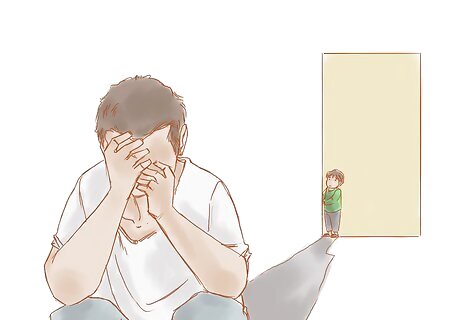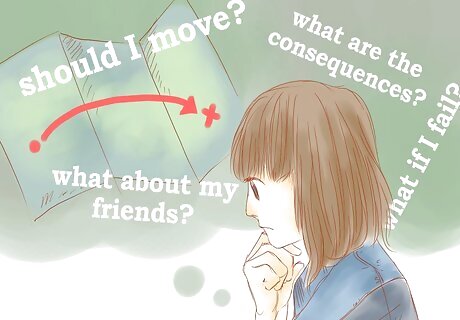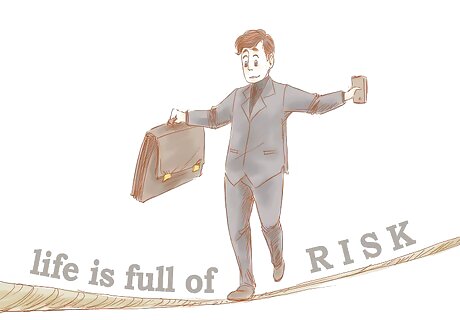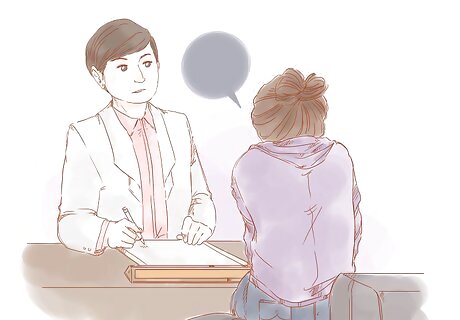
views
Identifying Negative Thought Spirals

Become a casual observer of your thoughts. The most effective way to recognize catastrophic thoughts is by tuning into the non-stop script running through your head. Simply bringing awareness to the thoughts you have can be a powerful tool to improve them. At this stage, you don’t need to take any action—just pay more attention to your thoughts. What kinds of things are you telling yourself? Some examples of common thoughts include "I can't do this. I'm not good enough," or "I never do anything right," or "I'm too fat. No one will ever love me."

Try to find recurring patterns. Do you find yourself thinking similarly at the same time each day, or before a certain task or activity? The time of day, task, or activity could be a stimuli or trigger for negative thought patterns. For example, maybe each day as you drive home from work you find yourself thinking “I’ll never get any time to relax. The kids will keep me going until bedtime.” Or, perhaps, before you go to the gym, you think “I bet everyone will be so embarrassed for me. I’m so out of shape.”

Pay attention to the connection your thoughts have with your feelings and actions. If you ever want to improve a behavior, you have to start with your thought patterns. Catastrophic thinking can prompt you to act irrationally, feel anxious, or even be self-defeating. If you are engaging in destructive behaviors, it’s time for you to pinpoint how your thoughts are influencing your actions. Write in a journal daily, or keep a daily mood log, that helps facilitate paying attention to your mood and what influences and/or triggers it, such as irrational and/or catastrophic thinking. You can write this information down, find a mood log app for your phone, or use a mood log website to help you do this. This will help you become more aware of the connections between what you were thinking, how you felt, and how you behaved as a result. For instance, you might take the above thought pattern “I bet everyone [at the gym] will be so embarrassed for me. I’m so out of shape.” Those thoughts might make you feel ashamed. As a result, you find yourself making excuses not to go to the gym.

Find the root of catastrophizing. After you have become an observer of your thoughts for a while, you need to start searching for the underlying cause of these thoughts. This can be tough to do, but give it your best shot. Look at the trigger of catastrophic thoughts then try to examine what these thoughts are suggesting. For example, you say “I’ll never get any time to relax. The kids will keep me going until bedtime” before you pull up at home. The root cause might be chronic stress from your parenting responsibilities. You feel like you are not in control, so your thoughts tend to take a negative route.

Distinguish between the irrational and rational. In some cases, thinking in a worst-case scenario pattern may be helpful for getting you out of trouble or preventing negative consequences. It's important to be able to recognize when your catastrophic thoughts are unlikely and illogical and when they deserve consideration. Your thoughts are irrational when the outcome is highly unlikely given the context. For example, you go to the doctor for a mild fever and assume you will be diagnosed with cancer. Your assumption is largely exaggerated. However, if you are sick, then a rational thought might be something like, “I might have the flu, or an infection, which needs to be treated.”
Disputing Worst Case Scenarios

Take a deep breath. An effective method for overcoming catastrophic thinking is taking a brief pause. Often, once your thoughts take a negative, self-defeating track you keep on down that road. Once you become more aware of the triggers and causes of your catastrophic thinking, you can learn to slow down and digest what’s happening before letting your thoughts take over. When you notice catastrophic thoughts, take a few minutes to practice deep breathing. This exercise can give you a moment to pause and think more rationally. It also helps alleviate stress. To do deep breathing, pull in air through your nose for several seconds. Hold the breath for 2 seconds. Then, exhale the breath from your mouth slowly. Repeat for several cycles.

Control what you can. Lack of control is often one of the root causes of catastrophic thinking. You feel helpless, so you let your thoughts lead—no matter how irrational they may be. Counteract this by finding at least one aspect of a situation that you can control. Focus on that. Let’s say, you’re worried that you will fail your English final. You find yourself thinking “I’ll fail the course and have to repeat it. This will ruin my GPA.” What can you control in this situation? You can control your performance on the test, so speak with the instructor and ask for study tips. Create a study guide or a practice test. Although you can’t control all the variables, by focusing on what you can control, you take back some of your power and you also reduce the stressor simultaneously.

Reverse your thoughts to the best-case possibility. Another method for disputing worst-case scenario thinking is by challenging yourself to look at the situation in reverse. Instead of dwelling on the worst possible outcome, envision the best possible result. This brings awareness to the fact that there are many possible outcomes—not just the worst. For example, your boyfriend fails to answer your calls 4 times in a row. You worry that something horrible has happened to him. Maybe he was mugged. Perhaps he had a car accident. You strongly consider calling the police. Rather than imagining catastrophe, think more positively. You were aware that your boyfriend has been really swamped at work. He’s been stressed out and sleeping poorly. Maybe he’s not answering your calls because he’s finally catching up on some zzz’s. How likely is this outcome?

Face fears head-on. Catastrophic thinking is often rooted in your worst fears. You dread something happening, and therefore give the event more power in your mind. Sometimes, taking action against catastrophic thinking means facing what you fear the most. In some cases, facing serious fears like phobias requires the assistance of a professional. However, if your fear is mild, challenge yourself to face it. For instance, if you have a fear of escalators, then you could start by watching other people ride on escalators. Then, as you get more comfortable watching other people ride on escalators, then you could ride on one yourself.

Meet with a therapist. In more severe cases of resistant catastrophic thinking or chronic phobias, you may need to work with a mental health therapist. A therapist can help you search for the root cause of your disastrous thoughts, figure out triggers, and develop skills to dispute unreasonable thoughts. Depending on how seriously your thoughts are impacting your life, you might need to try cognitive behavioral therapy or even medication to reduce the symptoms of anxiety. Talk to your doctor about possible treatment options. Your family doctor can also refer you to an experienced therapist in your area.
Seeing the Dangers of Catastrophizing

Recognize how catastrophic thinking increases stress hormones. Catastrophic thinking is unhealthy because imagining the worst puts your body through the same ordeal it would if the worst was actually happening. By thinking of terrible scenarios, your body is flooded with the stress hormone, cortisol. You have a fight or flight response in which everything is heightened—your heart beats faster, your palms sweat, and adrenaline courses through your body. This response is healthy when you’re actually in danger, but it’s counterintuitive when you’re not. Plus, when you suffer from chronic stress, you end up feeling constantly on edge. This compromises your immune system, interferes with your thought processes, and hinders sleep.

Resist the temptation to use unhealthy coping mechanisms. Many people who experience recurrent catastrophic thoughts have trouble handling them. As a result, they turn to negative coping mechanisms like risky sex, overeating, gambling, alcohol and drugs. If you suffer from nonstop catastrophic thinking and can’t seem to get it under control, see a therapist right away. Getting the help you need could prevent you from developing another serious problem like an addiction.

Realize your risk for a full-blown mental disorder. Your tendency to magnify problems and blow them out of proportion can be a sign of a budding psychiatric illness. If your negative thought patterns are difficult to dispute, get help from a trained psychologist or mental health therapist. Research shows that catastrophic thinking is directly related to psychopathology and is a feature in many conditions such as panic disorder, social phobia, obsessive compulsive disorder, and post-traumatic stress disorder.




















Comments
0 comment